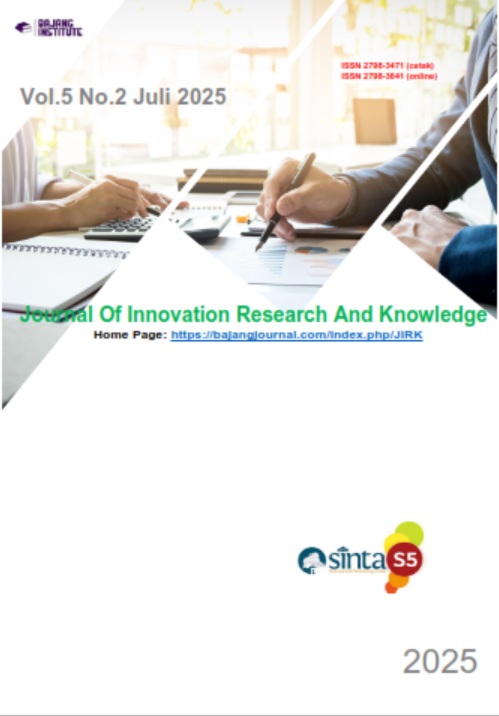KOMUNIKASI PEMASARAN DALAM INDUSTRI GIM PASCA COVID-19: TINJAUAN SISTEMATIS DENGAN METODOLOGI PRISMA
Keywords:
Marketing Communication, Game Industry, COVID-19Abstract
This study examines the development of the marketing communication within the video game industry following the COVID-19 pandemic through a systematic literature review, employing the Preferred Reporting Items for Systematic Review and Meta-Analyses (PRISMA) methodology. In response to the rapid digitalization triggered by COVID-19, companies have shifted how they engage with audiences by adopting new strategies such as social media, livestreaming, Esports, and narrative-building in online spaces. Academic studies have identified an expansion in the video game literature, however, notable gaps remain. By analyzing peer-reviewed literature from 2018 onward, this study identifies trends and discourses. Findings reveals that, although marketing strategies have changed, current academic discussions are fragmented and lack integration. Future studies should focus on distinguishing pre- and post-COVID-19 strategies to emphasize their relevance and develop comprehensive framework capable of analyzing the interdisciplinary nature of this field
References
August, N., & Paramita, S. (2022). Komunikasi Pemasaran Digital Streamer dalam Industri Game Online Indonesia.
Bakach, H. (2024). Understanding Influencer Marketing in the Gaming Industry: The role of social influence and engagement-Conceptual model proposition. https://doi.org/10.5281/zenodo.11218143
Baltezarević, R., Baltezarević, B., & Baltezarević, I. (2024). Advantages of digital marketing in the world of digital games. International Review, 1–2, 69–76. https://doi.org/10.5937/intrev2401069b
Basev, E. S. (2022). Game-Based Advertisement: Uludag Lemonade and Lipton Ice Tea Example. Erciyes İletişim Dergisi, 9(1), 77–95. https://doi.org/10.17680/erciyesiletisim.983743
Boghe, K., Herrewijn, L., De Grove, F., Van Gaeveren, K., & De Marez, L. (2020). Exploring the effect of in-game purchases on mobile game use with smartphone trace data. Media and Communication, 8(3), 219–230. https://doi.org/10.17645/mac.v8i3.3007
Burgess, J., Williams, P., Muscat, A., Grace, A., Jones, C., Curran, A., & Voelker, J. (2024). Managing the narratives in narrative media brands. Journal of Media Business Studies. https://doi.org/10.1080/16522354.2024.2369976
Chen, B. (2023). The Impact of Marketing Strategy on Consumers’ Purchasing Decisions in the Computer Gaming Aspect. In Business, Economics and Management EMFT (Vol. 19).
Chuang, Y. W. (2020). Promoting consumer engagement in online communities through virtual experience and social identity. Sustainability (Switzerland), 12(3). https://doi.org/10.3390/su12030855
Dardis, F., Schmierbach, M., Sherrick, B., & Luckman, B. (2019). How game difficulty and ad framing influence memory of in-game advertisements. Journal of Consumer Marketing, 36(1), 1–11. https://doi.org/10.1108/JCM-07-2016-1878
Gawrysiak, J., Burton, R., Jenny, S., & Williams, D. (2020). Using Esports Efficiently to Enhance and Extend Brand Perceptions-A Literature Review. Physical Culture and Sport, Studies and Research, 86(1), 1–14. https://doi.org/10.2478/pcssr-2020-0008
Goh, E., Al-Tabbaa, O., & Khan, Z. (2023). Unravelling the complexity of the Video Game Industry: An integrative framework and future research directions. Telematics and Informatics Reports, 12. https://doi.org/10.1016/j.teler.2023.100100
Gong, S., Wang, W., & Li, Q. (2019). Marketing communication in the digital age: online ads, online WOM and mobile game adoptions. Nankai Business Review International, 10(3), 382–407. https://doi.org/10.1108/NBRI-12-2018-0073
Hanbazazah, A., Reeve, C., & Abuljadail, M. (2022). Influence of Advergames on Brand Outcomes and Cross-Cultural Consumer Behaviour. International Business Research, 15(8), 1. https://doi.org/10.5539/ibr.v15n8p1
Jimenez, N., San-Martin, S., Camarero, C., & San Jose Cabezudo, R. (2019). What kind of video gamer are you? Journal of Consumer Marketing, 36(1), 218–227. https://doi.org/10.1108/JCM-06-2017-2249
King, D. L., Delfabbro, P. H., Billieux, J., & Potenza, M. N. (2020). Problematic online gaming and the COVID-19 pandemic. Journal of Behavioral Addictions, 9(2), 184–186. https://doi.org/10.1556/2006.2020.00016
Li, N., & Chaipoopirutana, S. (2020). An Empirical Investigation of Video Game Control Users: Examining the influence of Social Media Advertising, Social Media Promotion, E-WOM, and Brand Image on Purchase Intention in China (Vol. 30).
Lim, C. T. N. (2024). Controller to Console: Tracing the Footsteps of Video Game Media Evolution in the Filipino Gaming Experience. Review of Integrative Business and Economics Research, 14, 72. https://www.researchgate.net/publication/380030232
Limanto, J., Semuel, H., & Adiwijaya, M. (2018). Factors affecting the purchase intention of virtual goods in mobile game clash royale. International Journal of Biological Sciences, 1(1), 45–56. https://doi.org/10.9744/IJBS.1.1.45-56
López-Sánchez, J. A., Patiño-Vanegas, J. C., Valencia-Arias, A., & Valencia, J. (2023). Use and adoption of ICTs oriented to university student learning: Systematic review using PRISMA methodology. Cogent Education, 10(2). https://doi.org/10.1080/2331186X.2023.2288490
Lorensius, M., Hutabarat, P., Leonard, C., & Edu, M. H. (2022). The Influence of Social Media Marketing, Electronic Word of Mouth and Consumer Engagement to Brand Loyalty: Study Case at the DOTA 2.
Lupinek, J. M., Yoo, J., Ohu, E. A., & Bownlee, E. (2021). Congruity of Virtual Reality In-Game Advertising. Frontiers in Sports and Active Living, 3. https://doi.org/10.3389/fspor.2021.728749
Mancini, M., Cherubino, P., Cartocci, G., Martinez, A., Di Flumeri, G., Petruzzellis, L., Cimini, M., Aricò, P., Trettel, A., & Babiloni, F. (2022). Esports and Visual Attention: Evaluating In-Game Advertising through Eye-Tracking during the Game Viewing Experience. Brain Sciences, 12(10). https://doi.org/10.3390/brainsci12101345
Nepomuceno, M. V., Rahemi, H., Cenesizoglu, T., & Charlin, L. (2023). Should We Feed the Trolls? Using Marketer-Generated Content to Explain Average Toxicity and Product Usage. Journal of Interactive Marketing, 58(4), 440–462. https://doi.org/10.1177/10949968231172153
Newzoo. (2024). 2024_Newzoo_Free_Global_Games_Market_Report.
Page, M. J., McKenzie, J. E., Bossuyt, P. M., Boutron, I., Hoffmann, T. C., Mulrow, C. D., Shamseer, L., Tetzlaff, J. M., Akl, E. A., Brennan, S. E., Chou, R., Glanville, J., Grimshaw, J. M., Hróbjartsson, A., Lalu, M. M., Li, T., Loder, E. W., Mayo-Wilson, E., McDonald, S., … Moher, D. (2021). The PRISMA 2020 statement: An updated guideline for reporting systematic reviews. In The BMJ (Vol. 372). BMJ Publishing Group. https://doi.org/10.1136/bmj.n71
Rathee, R., & Rajain, P. (2019). Advergames: Factors, Attitude and Purchase Intention. Effulgence-A Management Journal, 17(Spl2), 47. https://doi.org/10.33601/effulgence.rdias/v17/ispl2/2019/47-57
Saraswari, D. P., Wulandari, S., & Normalia, I. (2022). Perancangan Perbaikan Strategi Komunikasi Pemasaran Game Citampi Stories menggunakan Metode Benchmarking dan Analytic Hierarchy Process (AHP). In Jurnal Pro Bisnis (Vol. 15, Issue 01).
Söğüt, F. (2021). Twitter Usage Practices of Digital Game Brands. Erciyes İletişim Dergisi, 8(2), 493–515. https://doi.org/10.17680/erciyesiletisim.883390
Zackariasson, P., & Wilson, T. L. (2012). The Video Game Industry.
Zhao, F., Alsagoff, S. A., Abdullah, K., & Wu, X. (2023). The Dynamics and Frontiers of Video Game Social Research in Communication Studies-A Scientometrics Analysis Based on CiteSpace and VOSviewer. Studies in Media and Communication, 11(7), 328–343. https://doi.org/10.11114/smc.v11i7.6423















